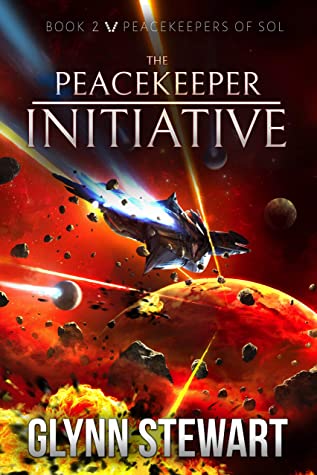Pros
- Some action-packed strategies and battles between ships and fleets in space
- Tension with space battles and conflict maintained throughout story
- Universe is populated with different aliens, even if most are humanoid—the reason here is a mystery within the story that may be later explored
Cons
- The journey to gather elements for the eventual assault feels more like a chore or a “fetch quest” that feels like it was included to extend the novel
The Peacekeeper Initiative Review
The Peacekeeper Initiative by Glynn Stewart continues with the action-packed storytelling involving Colonel Henry Wong and his battlecruiser, Raven. Unlike other military science fiction stories where the protagonists are severely unprepared or underpowered, Wong has at his disposal one of the most powerful ships in the sector under his command.
In a way, many military science fiction stories follow a similar pattern of evolution wherein one species develops a defense which another species later develops a solution to bypass that defense. What comes to mind immediately is the giraffe and its thick tongue, which allows the animal to eat plants that developed thorns for protection.
This cat-and-mouse game keeps the story a bit lively and gives Wong’s opponents a fighting chance, along with their superior numbers and willingness to play dirty. The plot of the story isn’t very standard in the sense that humans in many science fiction stories don’t often find themselves as peacekeepers. In fact, quite the opposite is true in many stories: humans are quite often the aggressors, or they’re often finding themselves on the defensive against a vastly superior alien foe.
The space battles in the story feel a bit more realistic in that the ships are limited by more physical constraints like the speed of light barrier. That means that Wong isn’t able to have faster-than-light communications, and his sensor data and weapons are bound by those rules too. These artificial constraints do keep the story suspenseful during battles and tense between battles.
The Peacekeeper Initiative teases readers with the mystery of why the Vesheron, the rebels that have organized against their Kenmiri oppressors, are humanoid. While the idea isn’t explored beyond a quick observation by Wong, this observation adds an element of mystery to the universe that begs to be explored. What do the Kenmiri know about this mystery, and what answers are just waiting to be discovered beyond Wong’s peacekeeping mission? The answers to these questions, and more, make the subsequent books worth reading.
One reason why science fiction is such a joy for readers is in its imagination of the various aliens that may populate the universe. Stewart manages to describe these aliens in a way that gives readers the sense that the universe is alive and filled with interesting aliens who have their own cultures, histories, and motivations. The clash of these differences, as well as the putting away of these differences in the interest of cooperation, make for an engaging story.
The Peacekeeper Initiative by Glynn Stewart is another fantastic military science fiction book for fans of the genre. The variety of aliens, the space battles, and the surrounding mystery of the origin of the Vesheron humanoids make for an interesting science fiction story.
Read reviews of other action-packed military science fiction books.



